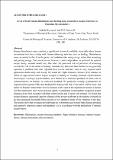Files in this item
Level of local human disturbance and feeding state determines escape behaviour in Eurasian Oystercatchers
Item metadata
| dc.contributor.author | Azaki, Bukola DA | |
| dc.contributor.author | Cresswell, Will | |
| dc.date.accessioned | 2022-08-30T23:43:54Z | |
| dc.date.available | 2022-08-30T23:43:54Z | |
| dc.date.issued | 2021-08-31 | |
| dc.identifier | 275696354 | |
| dc.identifier | 0dbd6399-1ba5-49c3-882b-b558f54f03bf | |
| dc.identifier | 85113853231 | |
| dc.identifier | 000691405500001 | |
| dc.identifier.citation | Azaki , B DA & Cresswell , W 2021 , ' Level of local human disturbance and feeding state determines escape behaviour in Eurasian Oystercatchers ' , Ethology , vol. Early View . https://doi.org/10.1111/eth.13220 | en |
| dc.identifier.issn | 0179-1613 | |
| dc.identifier.other | RIS: urn:F1743C0EF9AD591BBB91F7B01EE1B932 | |
| dc.identifier.other | ORCID: /0000-0002-4684-7624/work/99465827 | |
| dc.identifier.uri | https://hdl.handle.net/10023/25919 | |
| dc.description.abstract | Human disturbances may constitute a significant stressor for wildlife, especially where human recreational activities overlap with fitness-enhancing activities such as feeding. Disturbances cause an animal to flee from the perceived predation risk, using energy, rather than remaining and gaining energy. Such reactions are, however, context-dependent, as predicted by optimal escape theory: animals should only flee when the perceived risk of predation of remaining exceeds the risk of starvation of leaving. Animals may also learn that humans do not generally represent a predation risk after repeated false alarms and then learn to only respond when approached deliberately and closely. We tested the Flight Initiation Distance (FID; distance at which an approached animal begins escape) of feeding or roosting Eurasian Oystercatchers Haematopus ostralegus (oystercatchers) to a human (as a simulated predator) in areas with or without humans on beaches in south-east Scotland. We predicted roosting oystercatchers to respond earlier (greater FID) than feeding birds because the risk of starvation will be lower, and earlier on beaches where there were no humans at the start of the experiment because a human will then represent a more novel predator signal. As predicted, oystercatchers escaped at greater distances away from the perceived threat when feeding and in areas with humans. We found that escape distances decreased (greater tolerance of the perceived threat) as the number of people in an area increased, but people being present or not explained more of the variation in the data. The results show that oystercatchers habituate on a short timescale to non-lethal human presence and generally respond to perceived predation risk in accordance with the predictions of optimal escape theory. | |
| dc.format.extent | 9 | |
| dc.format.extent | 492761 | |
| dc.language.iso | eng | |
| dc.relation.ispartof | Ethology | en |
| dc.subject | Flight initiation distance | en |
| dc.subject | Habituation | en |
| dc.subject | Human disturbance | en |
| dc.subject | Human-simulated predator | en |
| dc.subject | Optimal escape theory | en |
| dc.subject | Risk assessment | en |
| dc.subject | GF Human ecology. Anthropogeography | en |
| dc.subject | QH301 Biology | en |
| dc.subject | DAS | en |
| dc.subject | AC | en |
| dc.subject.lcc | GF | en |
| dc.subject.lcc | QH301 | en |
| dc.title | Level of local human disturbance and feeding state determines escape behaviour in Eurasian Oystercatchers | en |
| dc.type | Journal article | en |
| dc.contributor.institution | University of St Andrews. School of Biology | en |
| dc.contributor.institution | University of St Andrews. Centre for Biological Diversity | en |
| dc.contributor.institution | University of St Andrews. Scottish Oceans Institute | en |
| dc.contributor.institution | University of St Andrews. Institute of Behavioural and Neural Sciences | en |
| dc.contributor.institution | University of St Andrews. St Andrews Sustainability Institute | en |
| dc.identifier.doi | 10.1111/eth.13220 | |
| dc.description.status | Peer reviewed | en |
| dc.date.embargoedUntil | 2022-08-31 |
This item appears in the following Collection(s)
Items in the St Andrews Research Repository are protected by copyright, with all rights reserved, unless otherwise indicated.

